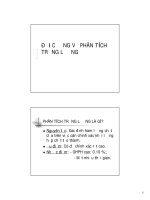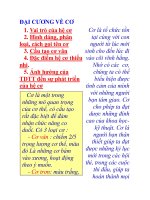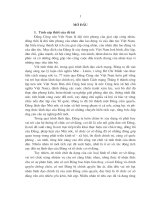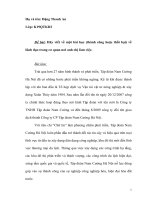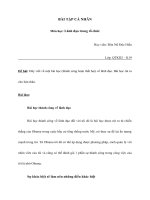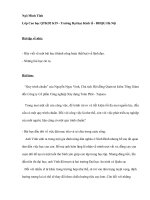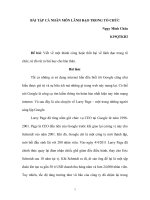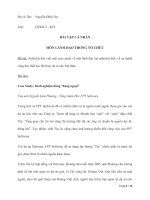Đại cương về lãnh đạo trong tổ chức chapter 3 leadership behaviour and motivation
Bạn đang xem bản rút gọn của tài liệu. Xem và tải ngay bản đầy đủ của tài liệu tại đây (600.66 KB, 59 trang )
.c
om
th
an
co
ng
Chapter 3
cu
u
du
o
ng
Leadership Behavior
and Motivation
Copyright © 2010 by South-Western/Cengage Learning
All rights reserved.
CuuDuongThanCong.com
PowerPoint Presentation by Rhonda S. Palladi
Georgia State University
/>
.c
om
Behavioral Theory Paradigm
cu
u
du
o
ng
th
an
co
ng
Following the study of traits in leaders,
researchers focused their attention on
studying what the leader says and does in
an effort to identify the differences in the
behavior of effective leaders versus
ineffective leaders
2
CuuDuongThanCong.com
/>
.c
om
Leadership Behavior
and Leadership Style
cu
u
du
o
ng
th
an
co
ng
Behavior is based on traits and skills
Relationships between leaders and
followers are based on the leaders’ traits
and attitudes
Relationships are good predictors of
employee behavior and performance
Leadership style is the combination of
traits, skills, and behaviors leaders use as
they interact with followers
3
CuuDuongThanCong.com
/>
.c
om
University of Iowa Leadership Styles
ng
Autocratic------------------------Democratic
an
co
Source: Adapted from K. Lewin, R. Lippett, and R.K. White, 1939. “Patterns of Aggressive Behavior in Experimentally
Created Social Climates.” Journal of Social Psychology 10: 271–301.
cu
u
du
o
ng
th
Autocratic: Leader makes decisions, tells
employees what to do, and closely
supervises them
Democratic: Leader encourages
participation in decisions, works with
employees to determine what to do, and
does not closely supervise them
4
CuuDuongThanCong.com
/>
.c
om
University of Michigan Leadership Model: Two
Leadership Styles, One Dimension
ng
Job-Centered
Employee-Centered
Leadership Style---------------------------Leadership Style
an
Job-centered leadership style:
co
Source: Adapted from R. Likert, New Patterns of Management. (New York: McGraw Hill, 1961)
du
o
ng
th
Refers to the extent to which the leader takes charge to get the job
done
The leader closely directs subordinates with clear roles and goals
The manager tells subordinates what to do and how to do it
Employee-centered leadership style:
cu
u
Has scales measuring two employee-oriented behaviors of supportive
leadership and interaction facilitation
The leader focuses on meeting the human needs of employees while
developing relationships
The leader is sensitive to subordinates and communicates to develop
trust, support, and respect
5
CuuDuongThanCong.com
/>
.c
om
Ohio State University
Leadership Model
ng
Behaviors identified:
Initiating structure behavior
co
Focuses on getting the task done
th
an
Consideration behavior
cu
u
du
o
ng
Focuses on meeting people’s needs and
developing relationships
6
CuuDuongThanCong.com
/>
High Structure
and
High Consideration
ng
th
an
co
Low Structure
and
High Consideration
u
du
o
Low Structure
and
Low Consideration
High Structure
and
Low Consideration
cu
C
o
n
s
i
d
e
r
a
t
i
o
n
ng
Ohio State University
High
Low
.c
om
The Ohio State University Leadership Model: Four
Leadership Styles, Two Dimensions
Initiating Structure
Low
High
Source: Adapted from R. Likert, New Patterns of Management. (New York: McGraw Hill, 1961)
CuuDuongThanCong.com
/>
7
.c
om
Which is the Best Leadership Style?
cu
u
du
o
ng
th
an
co
ng
There is no one best leadership style in all
situations.
There has been a consistent finding that
employees are more satisfied with a
leader who is high in consideration.
8
CuuDuongThanCong.com
/>
1,9
9,9
Team leader
co
ng
Country-club
leader
.c
om
Blake, Mouton, and McCanse
Leadership Grid
th
5,5
du
o
ng
Middle-of-the-road
leader
9,1
Authoritycompliance leader
u
1,1
cu
Impoverished
leader
an
Concern
for
People
Concern for Production
Source: Adapted from Robert R. Blake and Jane S. Mouton, The Managerial Grid III (Houston: Gulf, 1985);
and Robert R. Blake and Anna Adams McCanse, Leadership Dilemmas—Grid Solutions (Houston: Gulf, 1991), 29.
CuuDuongThanCong.com
/>
9
.c
om
The Leadership Grid
Impoverished (1,1)
th
an
co
ng
Low concern for production
Low concern for people
The leader does the minimum required to
remain employed
du
o
ng
Authority-compliance (9,1)
cu
u
High concern for production
Low concern for people
The leader focuses on getting the job done
while people are treated like machines
10
CuuDuongThanCong.com
/>
.c
om
The Leadership Grid (cont.)
Country club (1,9)
an
co
ng
High concern for people
Low concern for production
The leader strives for a friendly atmosphere
ng
th
Middle of the road (5,5)
cu
u
du
o
Medium concern for production
Medium concern for people
The leader strives for satisfactory
performance and morale
11
CuuDuongThanCong.com
/>
.c
om
The Leadership Grid (cont.)
Team (9,9)
cu
u
du
o
ng
th
an
co
ng
High concern for people
High concern for production
The leader strives for maximum performance
and employee satisfaction
12
CuuDuongThanCong.com
/>
.c
om
Importance of Research in
Behavior-Based Leadership
cu
u
du
o
ng
th
an
co
ng
Led to a shift in the leadership paradigm
to contingency leadership theory
Recognized that organizations need both
production and people leadership
Supported that most leadership functions
can be carried out by someone besides
the designated leader of a group (i.e.,
idea of participative leadership
introduced)
13
CuuDuongThanCong.com
/>
.c
om
Motivation
cu
u
du
o
ng
th
an
co
ng
Is anything that affects behavior in
pursuing a certain outcome
The pursuit of happiness and satisfaction
is fundamental to motivation
Making employees happier and healthier
increases their effort, contributions, and
productivity
14
CuuDuongThanCong.com
/>
.c
om
The Motivation Process
cu
u
du
o
ng
th
an
co
ng
People go from need to motive to
behavior to consequence to satisfaction
or dissatisfaction
A need or want motivates all behavior
Needs and motives are complex
Understanding needs helps the leader to
better understand motivation and
behavior
Motives cannot be observed; only
behavior can be witnessed
15
CuuDuongThanCong.com
/>
Behavior
Consequence
Satisfaction or Dissatisfaction
ng
th
an
Motive
u
du
o
Feedback
cu
Need
co
ng
.c
om
The Motivation Process (cont.)
16
CuuDuongThanCong.com
/>
.c
om
Major Motivation Theories
CLASSIFICATION OF
MOTIVATION THEORIES
SPECIFIC MOTIVATION THEORY
co
ng
A. Hierarchy of needs theory
B. Two-factor theory
C. Acquired needs theory
th
an
1. Content motivation theories
(Focus on explaining and
predicting behavior based on
employee need motivation)
A. Equity theory
B. Expectancy theory
C. Goal-setting theory
3. Reinforcement theory
(Proposes that behavior can
be explained, predicted, and
controlled through the
consequences for behavior)
Types of Reinforcement
• Positive
• Avoidance
• Extinction
• Punishment
cu
u
du
o
ng
2. Process motivation theories
(Focus on understanding how
employees choose behaviors
to fulfill their needs)
17
CuuDuongThanCong.com
/>
.c
om
Content Motivation Theories
cu
u
du
o
ng
th
an
co
ng
Focus on explaining and predicting
behavior based on people’s needs
The primary reason people do what they
do is to meet their needs or to satisfy
their wants
18
CuuDuongThanCong.com
/>
.c
om
Content Motivation Theories (cont.)
cu
u
Hierarchy of
Needs
du
o
ng
th
an
co
ng
Content Motivation
Theories
Acquired
Needs
Two-Factor
19
CuuDuongThanCong.com
/>
.c
om
Hierarchy of Needs Theory
cu
u
du
o
ng
th
an
co
ng
In the 1940s, Abraham Maslow developed
his hierarchy of needs theory
Based on four major assumptions
20
CuuDuongThanCong.com
/>
.c
om
Maslow’s Assumptions
cu
u
du
o
ng
th
an
co
ng
Only unmet needs motivate
People’s needs are arranged in order of
importance going from basic to complex
People will not be motivated to satisfy a
higher-level need unless the lower-level
need(s) has been least minimally satisfied
People have five classifications of needs
21
CuuDuongThanCong.com
/>
.c
om
Maslow’s Hierarchy of Needs
an
co
ng
SelfActualization
Needs
ng
th
Esteem Needs
cu
u
du
o
Social Needs
Safety Needs
Physiological Needs
22
CuuDuongThanCong.com
/>
.c
om
Maslow’s Hierarchy of Needs (cont.)
Physiological needs
u
du
o
ng
th
an
co
ng
Air
Food
Shelter
Sex
Relief from or avoidance of pain
cu
23
CuuDuongThanCong.com
/>
.c
om
Maslow’s Hierarchy of Needs (cont.)
Safety needs
co
ng
Safety
Security
ng
u
du
o
Love
Friendship
Acceptance
Affection
cu
th
an
Belongingness (Social) needs
24
CuuDuongThanCong.com
/>
.c
om
Maslow’s Hierarchy of Needs (cont.)
co
an
th
u
du
o
ng
Ego
Status
Self-respect
Recognition
Self-confidence
Prestige
cu
ng
Esteem needs
25
CuuDuongThanCong.com
/>
